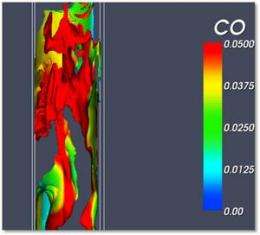Building gasifiers via simulation

A team of scientists from the National Energy Technology Laboratory (NETL) is using Oak Ridge National Laboratory's (ORNL's) Jaguar supercomputer, located at the Oak Ridge Leadership Computing Facility (OLCF), to conduct high-reliability simulations of a coal gasifier in an attempt to make the potential energy alternative more efficient and reliable. The project also aims to demonstrate the impact of simulation on reducing the cost and time required to develop the zero-emissions power plants of the future.
Gasification is the process through which carbonaceous material such as coal, petroleum, or biomass is converted into carbon monoxide and hydrogen by reaction of the raw material with controlled amount of oxygen or steam at high temperatures. The resulting gas mixture is called syngas, which is a fuel itself.
The NETL team is specifically working with coal gasification.
"Our work has provided an in-depth look at the interactions between the hydrodynamics and chemistry inside a commercial-scale gasifier," said Chris Guenther, research scientist in NETL's Computational Science Division and project leader. "This ability to finely resolve relevant structures inside a dense, reactive gas-solid system is not only unique, but also necessary to accelerate the commercial deployment of advanced gasification technology."
Simulation of this complex process requires enormous computing power, such as ORNL's Jaguar, one of the world's fastest supercomputers with a peak speed of 2.33 petaflops, or more than two thousand trillion calculations per second.
Guenther's team employs the Multiphase Flow with Interphase eXchanges (MFiX) code, used for simulating the multiphase flows within gasifiers. Multiphase refers to the process of changing a solid (in this case, coal) to a gas (syngas). MFiX was developed at NETL for describing the hydrodynamics, heat transfer, and chemical reactions in fluid-solids systems such as current gas-fired stations, which use very large boilers to produce steam for turbines.
The project is finishing the third and final year of its Innovative and Novel Computational Impact on Theory and Experiment program award, which granted the team 44.4 million hours on Jaguar and the Intrepid supercomputer at Argonne National Laboratory. The program allocates hours to large-scale, computationally-intensive research projects in a range of areas including fusion, climate, and materials. NETL funded the research.
"In 2007 the project received hours through the OLCF's director's discretion, an allocation that allowed for only 10 to 100 processors on the supercomputers," said Ramanan Sankaran, computational scientist at the OLCF. After receiving the INCITE allocations, however, the project was able to quickly scale up to 5,000 to 10,000 processors and recently conducted simulations on more than 70,000 processors, substantially increasing the resolution of the simulations.
Now, the scientists are able to run detailed simulations on the coal inlet region into the gasifier, allowing them to observe the dynamics. They are also able to do grid independence studies, which means refining the simulations until the results no longer change. This lets them know where they need to be with the simulation resolution and what information might be lost if the simulations are conducted at lower resolutions.
A standard run, Sankaran explained, usually takes a month to complete. The first simulations were of the hydrodynamics of the gas and solids and the subsequent mixing reactions. Two such chemical reactions can occur: heterogeneous (water and volatile matter at the surface of the coal) and homogeneous (occurring just within the gas phase). The goal is to simulate the complete thermal and chemical conversion of the coal as it travels through the gasifier while at the same time accounting for the effects of hydrodynamics on the process.
"The question is how do you effectively mix your coal with your oxidizer so that you get the optimum mix of carbon monoxide and hydrogen at the outlet? That is what a gasifier does," said Sreekanth Pannala, a computational scientist in the Computer Science and Mathematics Division at ORNL. Pannala also noted that the MFiX code is perfectly suited to modeling this phenomenon. The initial effort with MFix involved validating its calculations to ensure expected results followed. The next effort will be to study the roles of the coal inlets and the effect that mixing has on both local syngas production and overall coal conversion.
The project is also working on creating several high-resolution gasifier simulations to provide feedback on the design of a commercial-scale gasifier system intended for NETL's Clean Coal Power Initiative. The initiative is a cost-shared venture by the government and industry to develop advanced technologies to supply clean, reliable, and affordable electricity to the United States. Its goal is to sequester 90 percent of the carbon from coal with minimal impact to the cost of electricity.
Madhava Syamlal, principal investigator of the project, summed it up as follows: "High-performance computing is allowing us to reveal and study features of the gas-solids flow in a gasifier to a degree never before possible, experimentally or computationally. The knowledge created from the study will help improve commercial gasifier design."
Given that coal is a possible source of energy for future electric power and liquid fuels as well as a potential substitute for natural gas, the research couldn't come at a better time.
Provided by Oak Ridge National Laboratory


















